A Forest in the Arizona Desert
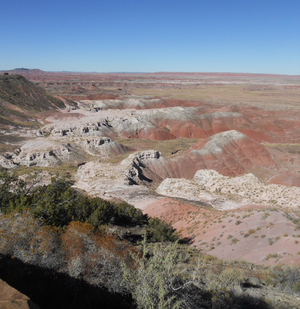 A petrified forest in the middle of the desert? I imagined shimmering forests of sparkling, stony wood soaring high overhead. Ancient conifers sealed in time with mossy-banked streams and forest critters scampering about . As we drove through the desert toward the Petrified Forest National Park in northern Arizona, without a tree or stream to be seen for miles around, something wasn’t adding up with the forest of my imagination.
A petrified forest in the middle of the desert? I imagined shimmering forests of sparkling, stony wood soaring high overhead. Ancient conifers sealed in time with mossy-banked streams and forest critters scampering about . As we drove through the desert toward the Petrified Forest National Park in northern Arizona, without a tree or stream to be seen for miles around, something wasn’t adding up with the forest of my imagination.
It was pretty clear that there was not going to be a lush, crystalline woodland anywhere near here, but what we did find was just as incredible. Our first stop at Petrified Forest National Park did not involve petrified wood, but offered views of the colorful expanse of the Painted Desert. At the edge of Painted Desert, the planed-flat desert that we drove in over cascaded downwards into deep gullies. Hills rose up from these depths in layers of vibrant color. The tallest hilltops reaching just back up to the height of the desert where we stood looking over.
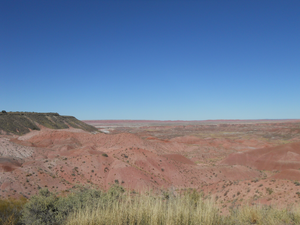 The painted hills blushed in rusty hues of reds and pinks atop fleshy shades tan and pale white. Viewing the landscape from above deceived the eye, the hills appearing at once enormous and undersized, like a scaled-down version of giant mountains. Upon walking down into the valley the hills grew large but still undersized, making us feel like giants surrounded by giants.
The painted hills blushed in rusty hues of reds and pinks atop fleshy shades tan and pale white. Viewing the landscape from above deceived the eye, the hills appearing at once enormous and undersized, like a scaled-down version of giant mountains. Upon walking down into the valley the hills grew large but still undersized, making us feel like giants surrounded by giants.
Petrified Forest National Park had more to offer than beautiful landscapes and petrifies wood—there was also evidence of cultures that lived in this punishing desert environment long before it became a tourist destination. Native American petroglyphs could be seen on Newspaper Rock–an ancient “newspaper” that told the stories of and ancient culture.
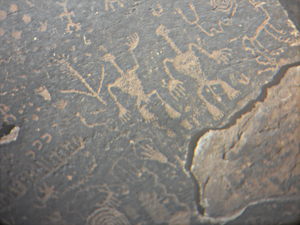 Newspaper rock was covered with ancient images representing native spirituality, calendars used for planting crops, and scenes of ancient life. In looking at these symbols we felt a connection with the artists–they had painted these drawings with their own hands with the intention of the drawings lasting for future generations to see.
Newspaper rock was covered with ancient images representing native spirituality, calendars used for planting crops, and scenes of ancient life. In looking at these symbols we felt a connection with the artists–they had painted these drawings with their own hands with the intention of the drawings lasting for future generations to see.
g 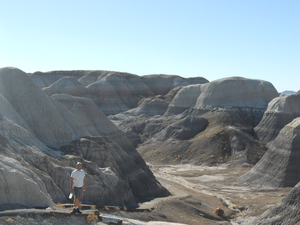 Like a desert sunset, the pink and red colors of the painted cliffs slipped into twilight shades of blue and gray as we headed south into the Blue Mesa area of the National Park. The badlands of Blue Mesa looked other-worldly; their gray-blue color was the same as the blue corn tortillas that are such popular food here in the southwest.
Like a desert sunset, the pink and red colors of the painted cliffs slipped into twilight shades of blue and gray as we headed south into the Blue Mesa area of the National Park. The badlands of Blue Mesa looked other-worldly; their gray-blue color was the same as the blue corn tortillas that are such popular food here in the southwest.
At Blue Mesa we got our first glimpse of the petrified logs after which the park was named. Some of these logs were perched on pedestals of earth that were created from the desert slowly eroding away underneath the ancient wood. The wood became more plentiful as we continued south.
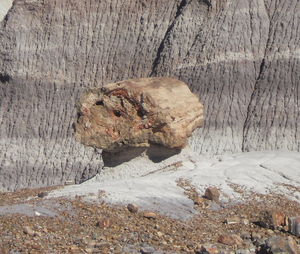 At last we arrived at the crystal forest. By this time, I was not surprised that this forest was not the shaded, lush, standing stone forest that I had imagined. The petrified logs that were strewn on the ground were merely skeletal ruins of and ancient forest that once stood. Like a mirage my vision evaporated into only more sun-scorched desert.
At last we arrived at the crystal forest. By this time, I was not surprised that this forest was not the shaded, lush, standing stone forest that I had imagined. The petrified logs that were strewn on the ground were merely skeletal ruins of and ancient forest that once stood. Like a mirage my vision evaporated into only more sun-scorched desert.
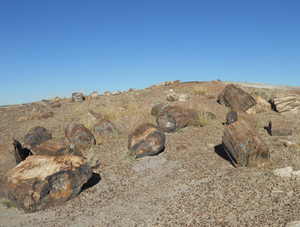 Walking among the fallen wood felt like walking through a graveyard. Trees lay unmoved from their resting places from millions of years ago, when the desert was the bottom of a great sea. The years had done there work on the tree trunks here in Arizona, replacing soft wood with quartz, copper, iron, and other minerals—resulting in the most stunningly colorful petrified wood in the world.
Walking among the fallen wood felt like walking through a graveyard. Trees lay unmoved from their resting places from millions of years ago, when the desert was the bottom of a great sea. The years had done there work on the tree trunks here in Arizona, replacing soft wood with quartz, copper, iron, and other minerals—resulting in the most stunningly colorful petrified wood in the world.
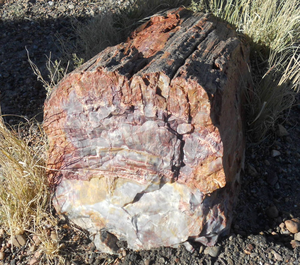 The landscape of Petrified Forest National Park contained as much color and beauty as can be found in a piece of the petrified wood itself. The power of nature and the enormity of time is apparent here through the creation and erosion of stone and the writings of ancient people. While I expected to find a forest of the traditional sense, instead I discovered the fate of a forest over 200 million years old. Now I know that my vision of the lush, towering forest was, long ago, very real.
The landscape of Petrified Forest National Park contained as much color and beauty as can be found in a piece of the petrified wood itself. The power of nature and the enormity of time is apparent here through the creation and erosion of stone and the writings of ancient people. While I expected to find a forest of the traditional sense, instead I discovered the fate of a forest over 200 million years old. Now I know that my vision of the lush, towering forest was, long ago, very real.

